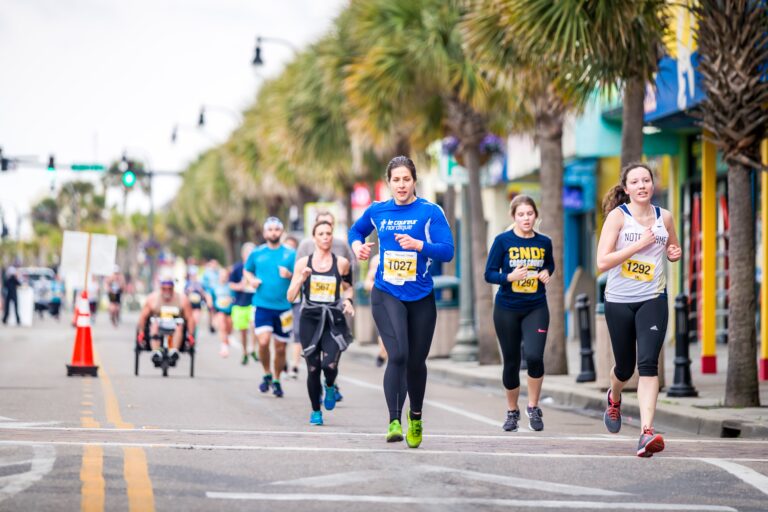Large races like marathons attract a lot of participants and raise money for charity, and their success can be recreated with smaller events such as 5k races or fun runs. Charity races are a great way to bring your community together for a cause. The combination of charitable donations with a healthy activity is appealing to many, especially around the holidays. If you’re unsure how to plan a 5k run/walk fundraiser, we’ve created this guide to take you through the process from start to finish.
Why organise a 5k walk or run?
Attendees love race events, and so do creators. Many people like to sign up for races as a way to motivate themselves to get healthier, which is why couch-to-5k exercise plans are popular. If your race is a few months away, you still want to market the event to potential attendees who may sign up far in advance as a way to motivate them on their fitness journey.
Shorter races appeal to groups of friends and family looking for a group activity to participate in, and adding a charitable component makes these races even more appealing. Participants often encourage their friends to join them and sometimes form teams to raise money and run the race together. There are also lots of community running groups that may be interested in participating in your event as they train for longer races.
Fun 5k race ideas can include giving the event a theme, such as Santa Claus races where everyone is encouraged to don their best Christmas outfits, or beer runs where participants (of age) are rewarded with a brew once they cross the finish line. No matter what, you want to come up with fun run ideas that appeal to your target audience, align with your brand’s values, and reflect the values of the charity you’re supporting.
Planning a 5k charity race might make it easier for creators like you to find willing sponsors, particularly those within the community. You can offer your sponsors the opportunity to put their branding on your race t-shirt or other freebies that are handed out to participants, ensuring that their name is seen by all attendees.
The starting line: planning your 5k race and getting people signed up
Before you start to sell tickets and market your event, there are important logistics to iron out first. Consider the following steps when you’re initially planning your race.
Choose your theme and type of race
Some races are named after their biggest sponsor or the charity the event is raising money for. Many others choose a theme to bring an extra layer of excitement to planning the event. If you want to encourage participants to dress up, make that clear in your marketing materials. Tailor your event to suit the charity you are supporting as well. For example, if you’re raising money for a children’s charity, you may want to plan a family-friendly event with a fun run component for young children.
It’s important to decide what kind of race you are hosting beforehand; a competitive race will require more planning and certifications, while a short fun run might be less logistically complicated. Virtual races, which have become much more popular since the onset of the COVID-19 pandemic, are a great way to reach runners outside of your immediate community. Participants in these races run a particular distance wherever they can during a certain time period. Runners log their run information before the time period is over. If you plan a virtual 5k, consider sending swag, like t-shirts and medals, directly to runners prior to the race. This allows runners to wear their race shirts while they complete the run, no matter where they are.
Set up a safe, certified route
When thinking about how to plan a 5k run/walk fundraiser, your race route is a critical consideration. Some racecourses may require you to stop traffic or close public trails temporarily. This may require approval or even permits from your local authorities. You should also procure insurance for the event and have first aid and medical assistance available just in case anyone is injured during the race.
Find the right sponsors
If you’re planning a 5k/fun run that supports a local organisation, the best sponsors to reach out to are the businesses in your community. Your sponsors don’t have to be directly related to running or exercise, but it may be beneficial to reach out to sporting goods stores, running clubs, health food stores, and gyms. Consider working with local restaurants or delis who would be willing to donate water, sports drinks, or food for participants after they’ve finished the race.
Set up your event page on Eventbrite
Once you’ve come up with a theme and handled the logistical aspects of your event, decide on your target market and how many people you hope to attract. This number will inform the amount of food and swag you’ll need for race day and determine the size of the area where your race is taking place. It will also help you set your ticket price.
You may want to offer your participants different pricing tiers, each with different perks. For example, you could offer one ticket tier that pays for race participation and guarantees a snack after the event, and another that includes participation, a snack, and a freebie such as a t-shirt or a medal.
Once you’ve planned out your ticketing tiers, create your event on Eventbrite. Add custom check-out questions, such as t-shirt sizes or dietary requirements, as needed.
Getting up and running
After choosing a theme, planning a route, acquiring your sponsors, and setting up your event page, it’s time to get into the final details of race planning. Prepare for race day with some of our tips.
Put together a great race packet
Race packets usually include a race bib, a clear bag for stowing personal items on race day, any forms participants need to fill out, and a t-shirt if you’re providing one. If you’re designing a race t-shirt, think about how to make it stand out. Runners typically have lots of race shirts, so consider what kinds of material, cut, and design will make yours a favourite. Print sponsor logos, and yours, on the shirt for some free future marketing.
Plan your post-race event
Decide what will happen at your post-race event, whether that’s sponsors giving out freebies, vendors selling food and gear, or even entertainment. Consider games or activities, such as a unique photo station or a raffle, to encourage participants to stick around after the race is over. Create a map of where you want sponsors and vendors to set up, and have a volunteer who specifically organises this process on the day.
Organise volunteers
Races usually require volunteers to help them run smoothly. Before the race, volunteers will be needed to hand out packets, check personal items, and direct runners to the starting line or specific corrals. You’ll need people stationed at various points along your race route to direct runners, hand out water, and contact medical assistance if necessary. After the race, volunteers will hand out food and freebies.
Secure your materials
You may need to procure technology that tracks the chips on the runners’ bibs to determine their accurate race time from start to finish. It’s a good idea to rent a sound system so runners can hear you announce the beginning of the race. Consider placing a leaderboard and digital clocks along the route to show the runners how much race time has elapsed. You’ll also need portable toilets near the start and finish lines and potentially at other points along the route. Other materials you may need to round up include food and water, tables for water stations, and flags or other markers for the route.
Plan for parking and transportation and designate a check area
Depending on your race location, you may need to designate an area for parking. If there’s no place to park at the race location, let participants know ahead of time where to find local parking garages or lots and what public transportation routes they can take.
Some runners may need to check some personal items while they’re participating in the race. Consider using a locker bank or designate an area for checking personal items. Provide a ticket with their bib number that they can attach to the bag so their bib acts as their “ticket” when they’re ready to pick up their items. Have volunteers stationed to make sure the checked items remain safe.
Get creative with fundraising
Incorporate other creative fundraising elements to your event to further support your chosen organisation. Give participants the option to add a donation during the ticket buying process. Encourage participants to raise money from their friends and family in the runup to the race, and consider giving the charity a booth or table at your post-race event where they can collect more donations.
Start your marketing campaign
Begin marketing your race a few months in advance via email, social media, and partnerships with local organisations. You may want to work with local gyms and running clubs to get more participants. Ask if flyers can be posted where runners or fitness enthusiasts can see them, or offer group discounts for gyms that organise a certain number of participants. Create a press release to submit to local news outlets or contact local papers or community boards about featuring the race.
Email previous participants or event attendees about your race and let them know if you have any early-bird discounts or offers. Race prices typically grow more expensive the closer the event day gets, so this marketing method is well-known to runners. Send out reminders when the price is about to go up to encourage more attendees to sign up. Eventbrite Boost can support you in marketing your event via email and social media once you’ve finished creating your event page.
Start posting on social media in advance to start garnering excitement for your event. Use images and videos from previous races to give attendees a visual idea of what the event will be like. Create a hashtag for the event and encourage attendees to use it on race day and when posting about the event afterwards.
The finish line
You’ve done the prep work and race day is finally here. You and your volunteers will want to get to your location early to set up and start directing participants when they arrive. Make sure you keep safety considerations in mind and get ready for a great day!
Mark your route
You will need to mark your race route so runners know where they’re going. Do this as early in the day as possible, or the day before the race if the local authorities will allow it. Consider using kilometre markers that will tell runners how far they’ve run already, and decide where you will have water and medical stations.
Distribute race packets
Decide whether participants will pick up their race packets or if you will mail them out. If you’re having runners pick up their packets in person, consider having a pickup location the day before race day so that not everyone is trying to get their packets at once.
Set up the course
Set up your start and finish line, leaderboards, and race time displays along the route. Get your sound system ready before participants start arriving, and have volunteers set up water stations, packet pickup, and food tables.
Have an emergency plan
Be sure there’s a communication process in place in the event that your event is postponed or cancelled due to extreme weather or other safety concerns. Races are large events that can draw crowds, so consider having security measures to keep runners and spectators safe.
Already planning a 5k fun run?
Pulling together a charity race requires a lot of pre-planning, but with an appealing theme and a solid marketing plan your event can draw in a large audience. If you already know how to plan a 5k run/walk fundraiser, then let us help you sell tickets to the event. Sign up for Eventbrite today and get started.






